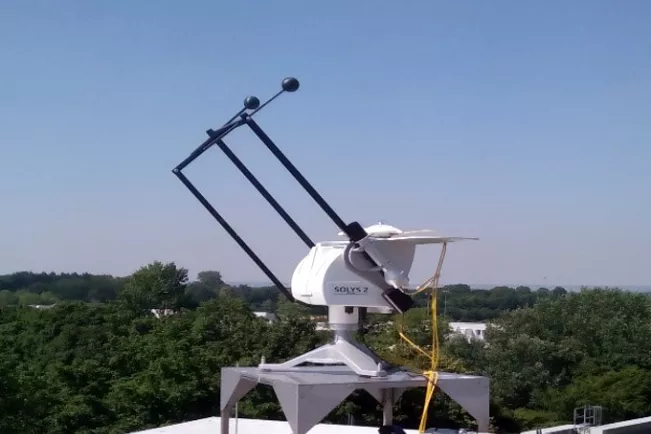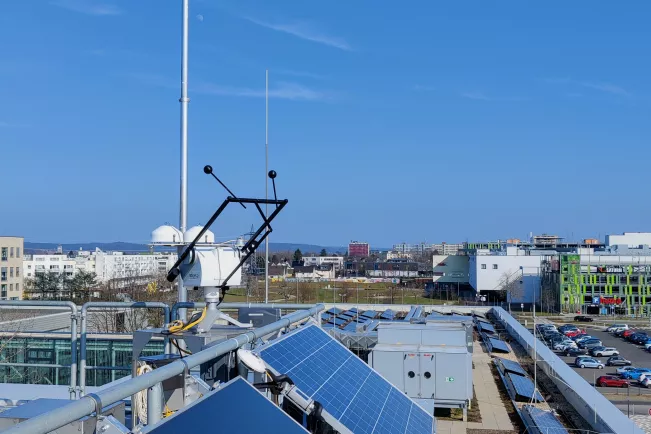Institute of Technology, Resource and Energy-efficient Engineering (TREE)
Energy Meteorology Lab

The measurements are supplemented by high-resolution radiation measurements (direct and diffuse components and spectrum), as well as photovoltaic (PV) yields of different module types (polycrystalline and amorphous silicon). In addition, two different cloud camera systems are used to record and analyze cloud situations. The laboratory serves the purpose of improving the forecast of radiation and the improved forecasts for the control of photovoltaic (PV) storage systems. On the one hand, we are investigating grid-integrated PV hybrid systems with batteries. In addition, we are also investigating PV power-to-gas-to-power systems, i.e. photovoltaic systems that are connected to hydrogen-metal hydride storage systems. To this end, we are working closely with the hydrogen laboratory at TREE. Using the simulation models we have developed, we are testing various forecast-based control algorithms for the above-mentioned systems.
„The management of the energy infrastructure must be adapted much more effectively to changing weather conditions. In particular, the decentralized feed-in and storage of electricity from PV systems presents distribution grid operators with new challenges when it comes to expanding and operating the grids of the future. As an atmospheric physicist, one of the central questions of my research is therefore how we can optimize yield forecasts for the control of grids and decentralized storage systems.”
Prof. Dr. Stefanie Meilinger - Professor for Sustainable Technologies, in particular Energy Efficiency and Renewable Energies, Department of IWK

Measuring devices of the Energy Meteorology Laboratory

This website provides an overview of the individual measuring devices with technical details, measured parameters and utilization of the data. The data from the Energy Meteorology Laboratory is used both for weather forecasts by Meteomedia and for research projects at the university. Below you will also find information on current and completed research projects as well as opportunities for research cooperation.
Weather station

Bonn-Rhein-Sieg University of Applied Sciences operates a WMO-compliant weather station at the Sankt-Augustin site. This is operated in cooperation with the company Meteomedia, which in turn provides location-optimized weather forecasts.
The station's sensors determine 10-minute average values for the following variables:
- Wind direction
- wind speed
- air temperature
- Relative humidity (calculated)
- Dew point (calculated)
- Earth surface temperature
- Amount of precipitation
- Precipitation status (yes/no)
- Global radiation
- Sunshine duration
Take a look at the current station readings from Meteomedia and the results of the Meteomedia forecast (in 3h resolution) for the next 4 days.
Sun Tracker - Radiation measurement

Global, diffuse and direct normal radiation are measured with the aid of a sun tracker.
Technical details:
- SOLYS 2 (Kipp & Zonen company)
- Two pyranometers, one with and one without shading, a third silicon-based pyranometer and a pyrheliometer (Kipp & Zonen)
- Ventialtion units to prevent dew formation
- Digital Combilog (Theodor Friedrichs & Co.) with a time resolution of the scan from 0.5s to 1h (time recording 1s to 12h)
- An Ethernet connection enables control and data download from the laboratory PC
All Sky Camera / Cloud Camera

With the help of a fish-eye camera, the cloud cover over the measuring station is recorded as a digital photo and the degree of cloud cover is analyzed. The camera observes the sky and takes pictures every minute with a fish-eye lens in a 360 degree radius. The camera takes 2 images simultaneously, one normally exposed and one underexposed, which can be analyzed by the Find Cloud software. In addition, a second camera records video footage to analyze the cloud situation. Data is exchanged between the measuring station and the laboratory via Ethernet. The images are continuously sent to the control PC.
In addition, two different cloud camera systems are used to record cloud situations and analyze them using machine learning, among other things.
Technical details:
- Cloud Cam ( company EKO)
- GV-EFER3700 (GeoVision company)
Photovoltaic test stand

Photovoltaic system I (polycrystalline silicon)
- Module type: SolarWorld SW 235-poly
- Yield measurement with < 1 second temporal resolution
- Regular recording of the U-I characteristic curve
- Measurement of the module rear side temperature and irradiation with various pyranometers
Photovoltaic system II (amorphous silicon)
- Module type: Thin-film solar module 45 Wp21V, Contrad Electronic SE
- Yield measurement exposed
Spectrometer

The spectrometer supplements the radiation measurements
- The spectrometer measures the spectrum of global radiation
- In a wavelength range from 350 - 1700 nm
- Measuring interval: (<=1 measurement/minute)
- Resolution: (FWHM: VIS ~1nm; NIR ~5nm; step size ~2nm)
- Input optics is an integrating sphere
- Manufacturer is the company CMS Schreder from Austria
- Data connection to the laboratory PC via an Ethernet connection (control and data management)
Research and cooperation

In many corporate strategies, collaboration with research institutions has long been established as an important element of open innovation. When it comes to specific research ideas or supporting entrepreneurial challenges, the university is on hand as a scientific partner with its expertise.
If you are interested in a collaboration, please contact us.
Further information
Kontakt

Stefanie Meilinger
Professor for Sustainable Technologies, esp. Energy Efficiency and Renewable Energies, Director of the International Centre for Sustainable Development (IZNE), Department Engineering and Communication (IWK)
Research fields
Location
Sankt Augustin
Room
F 321
Address
Grantham-Allee 20
53757 Sankt Augustin
Telephone
+49 2241 865 718


